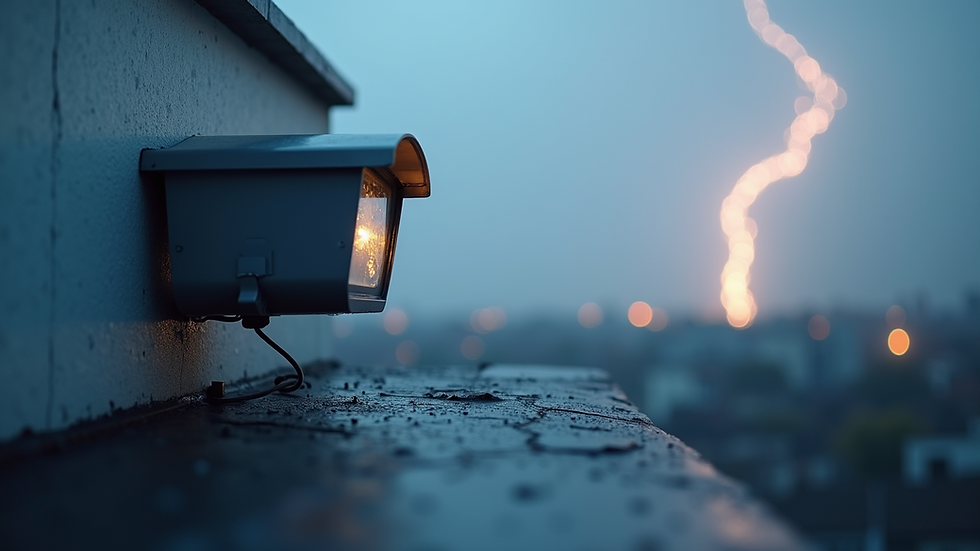Preventing Future Lightning Damage: Expert Solutions
- Lightning Strike Investigators

- Aug 21, 2025
- 4 min read
Lightning strikes can be both awe-inspiring and terrifying. Each year, thousands of homes and businesses suffer damage from lightning strikes. The aftermath can be costly and stressful. However, there are effective ways to prevent future lightning damage. In this post, we will explore expert solutions that can help protect your property from the dangers of lightning.
Understanding Lightning Damage
Before we dive into prevention methods, it is essential to understand how lightning can damage your property. Lightning is a powerful electrical discharge that can strike buildings, trees, and other structures. When lightning strikes, it can cause fires, electrical surges, and physical damage to the structure itself.
Common Types of Lightning Damage
Fire Damage: Lightning can ignite flammable materials, leading to devastating fires.
Electrical Surges: A lightning strike can cause a sudden surge of electricity, damaging electrical systems and appliances.
Structural Damage: The force of a lightning strike can physically damage roofs, walls, and other structural components.
Tree Damage: Trees can be split or uprooted by lightning strikes, posing a risk to nearby structures.
Understanding these types of damage is crucial for homeowners and business owners alike. By knowing what can happen, you can take steps to protect your property.
Lightning Protection Systems
One of the most effective ways to prevent lightning damage is to install a lightning protection system. These systems are designed to safely direct lightning strikes away from your property.
Components of a Lightning Protection System
Air Terminals: Also known as lightning rods, these are placed at the highest points of a building to attract lightning.
Conductors: These are cables that connect the air terminals to the ground, allowing the electrical charge to flow safely away from the structure.
Grounding System: This system disperses the electrical charge into the ground, preventing damage to the building.
Benefits of Installing a Lightning Protection System
Increased Safety: A properly installed system can significantly reduce the risk of fire and electrical damage.
Insurance Benefits: Many insurance companies offer discounts for properties with lightning protection systems.
Peace of Mind: Knowing your property is protected can provide peace of mind during stormy weather.
Surge Protection Devices
In addition to a lightning protection system, installing surge protection devices (SPDs) is essential. These devices help protect your electrical systems from surges caused by lightning strikes.
How Surge Protection Devices Work
SPDs are designed to detect voltage spikes and redirect excess electricity away from sensitive equipment. They can be installed at various points in your electrical system, including:
Main Service Panel: Protects the entire electrical system.
Point-of-Use Devices: Protects individual appliances and electronics.
Choosing the Right Surge Protection Devices
When selecting SPDs, consider the following:
Voltage Rating: Ensure the device can handle the voltage levels in your area.
Clamping Voltage: Look for devices with a low clamping voltage for better protection.
Response Time: Choose devices that respond quickly to surges.
Regular Maintenance and Inspections
Preventing lightning damage is not a one-time effort. Regular maintenance and inspections are crucial to ensure your protection systems are functioning correctly.
What to Inspect
Lightning Protection System: Check for any signs of wear or damage to the air terminals and conductors.
Surge Protection Devices: Test SPDs regularly to ensure they are operational.
Electrical Systems: Have a qualified electrician inspect your electrical systems for any vulnerabilities.
Creating a Maintenance Schedule
Establish a routine maintenance schedule to keep your systems in top shape. Consider seasonal inspections, especially before storm season. This proactive approach can save you from costly repairs down the line.
Landscaping Considerations
Your landscaping can also play a role in lightning protection. Certain trees and plants can attract lightning, while others can help mitigate risks.
Safe Landscaping Practices
Avoid Tall Trees: Do not plant tall trees near your home. If you have existing tall trees, consider trimming them back.
Plant Low-Growing Shrubs: These can help reduce the risk of lightning strikes.
Create a Safe Zone: Maintain a clear area around your home, free of tall structures that could attract lightning.
Educating Your Family and Employees
Education is a vital part of lightning safety. Ensure that everyone in your household or workplace understands the risks and knows what to do during a lightning storm.
Lightning Safety Tips
Stay Indoors: During a storm, stay inside and away from windows.
Avoid Electrical Appliances: Do not use wired electronics during a storm.
Know the Warning Signs: Be aware of the signs of an approaching storm, such as darkening skies and distant thunder.
Investing in Insurance
While prevention is key, having the right insurance coverage is also essential. Ensure your property is adequately insured against lightning damage.
Types of Insurance to Consider
Homeowners Insurance: Most policies cover lightning damage, but check your specific coverage.
Business Insurance: If you own a business, ensure your policy includes coverage for lightning-related damages.
Reviewing Your Policy
Regularly review your insurance policy to ensure it meets your current needs. If you have made improvements to your lightning protection systems, inform your insurance provider. This may lead to lower premiums.
Conclusion: Taking Action for a Safer Future
Lightning damage can be devastating, but with the right precautions, you can protect your property. By investing in lightning protection systems, surge protection devices, and regular maintenance, you can significantly reduce the risk of damage.
Educating your family and employees about lightning safety is equally important. Remember, prevention is always better than cure. Take action today to ensure a safer future for your home or business.

By following these expert solutions, you can enjoy peace of mind during stormy weather. Protect your property and your loved ones from the dangers of lightning.




Comments